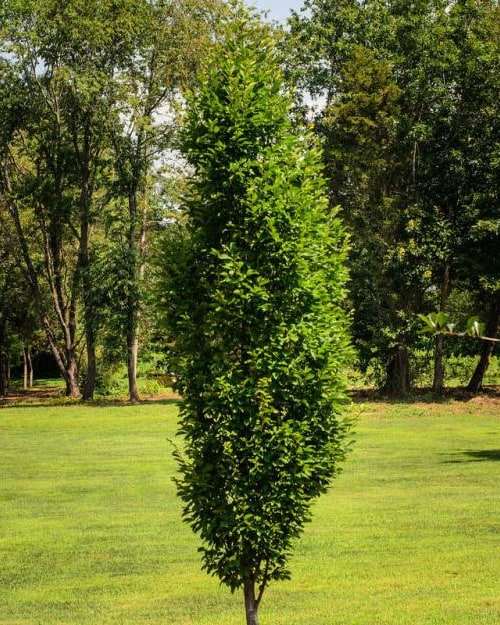Of all the cultivars of European hornbeam (Carpinus betulus), ‘Frans Fontaine’ stands out as one of the most prized. This handsome, slow-growing tree has an upright oval form and lush green foliage that provides multi-season interest. For landscapes seeking a refined, architectural look, ‘Frans Fontaine’ hornbeam is hard to beat.
Origins of a Top-Tier Cultivar
‘Frans Fontaine’ arose in the 1930s as a chance seedling at a nursery in Boskoop, Netherlands. It was named after the nursery’s owner, Frans Fontaine. ‘Frans Fontaine’ proved superior to the species in its compact, columnar habit and reliability to thrive in urban settings.
Other C. betulus cultivars like ‘Fastigiata’ and ‘Pyramidalis’ share the upright growth but lack the consistency and vitality of ‘Frans Fontaine.’ As a result, ‘Frans Fontaine’ has emerged as the premiere hornbeam cultivar for modern landscapes.
Notable Attributes
Mature ‘Frans Fontaine’ hornbeams reach 30-40 feet high and 15-20 feet wide Their form is narrowly pyramidal to columnar, with strongly ascending branches The foliage emerges with a rich spring green color, darkening to deep green in summer.
Fall brings golden yellow to orange-red autumn tones. The leaves persist well into winter before dropping. ‘Frans Fontaine’ is hardy to USDA zone 4 and adapts well to soils from acidic to alkaline.
Uses in Landscape Design
With its tightly upright habit, ‘Frans Fontaine’ hornbeam serves as an exclamation point in the garden. It makes an excellent vertical accent by walkways, entries and corners. Lines of ‘Frans Fontaine’ make striking alleyways and living screens.
In formal designs, it lends structure pruned into hedges or topiary. ‘Frans Fontaine’ works nicely in containers too. Its compact size suits urban sites like sidewalk cutouts and small yards.
Care and Management
‘Frans Fontaine’ thrives on minimal care once established. It prefers full sun but tolerates partial shade. Occasional pruning in early summer shapes and maintains its columnar form. Like other hornbeams, ‘Frans Fontaine’ is relatively pest and disease free.
For small spaces seeking a refined vertical accent, few trees compare to Carpinus betulus ‘Frans Fontaine.’ This distinguished cultivar combines strong architecture, four-season appeal, adaptability and elegant proportions. ‘Frans Fontaine’ hornbeam richly deserves its reputation as the premier hornbeam for modern landscapes.

What in the world is a European Hornbeam? | Plant Spotlight
FAQ
How big do Carpinus betulus frans fontaine get?
What are the cons of hornbeam?
How fast does Carpinus betulus grow?
How do you care for a Frans Fontaine hornbeam?
What is Carpinus betulus Frans Fontaine?
Bred in Holland, Carpinus betulus Frans Fontaine is a compact and upright cultivar of the hornbeam, making it suitable for smaller gardens. Long-lived, medium-sized, deciduous tree with an attractive form, even in winter. Glossy, mid-green, beech-like leaves, turning golden in autumn.
What is Frans Fontaine hornbeam?
Frans Fontaine Hornbeam is a dense deciduous tree with a narrowly upright and columnar growth habit. Its relatively fine texture sets it apart from other landscape plants with less refined foliage. This is a relatively low maintenance tree, and is best pruned in late winter once the threat of extreme cold has passed.
Can Carpinus betulus be used as a hedge?
Carpinus betulus is relatively trouble-free and tolerates a wide range of soil conditions and some shade. This plant is also very tolerant of heavy pruning, making it useful as a hedge. The cultivar ‘Frans Fontaine’ is a tight, narrow, columnar cultivar with densely set branches and leaves.
What is Carpinus ‘Fastigiata’ (Hornbeam Tree)?
Carpinus ‘Fastigiata’, also known as the Hornbeam Tree, is a distinctive, erect form of the native hornbeam that forms a flame-shaped tree. It is neater and denser than the simple species and grows quite fast while young, producing a neat formal shape, almost triangular in silhouette. The dark green foliage turns yellow and orange in the autumn.
What are Carpinus betulus pleached hornbeam trees?
These Carpinus Betulus Pleached Hornbeam Trees are trained on a clear stem onto tall bamboo frames and used as a contemporary stilted hedge or screen above the fence line. Grown in this way, Carpinus Betulus Pleached trees can also be used as a stand-alone panel to create a backdrop to a special garden ornament, urn or sculpture.
Does Frans Fontaine hornbeam have negative characteristics?
It has no significant negative characteristics. Frans Fontaine Hornbeam is recommended for the following landscape applications; Frans Fontaine Hornbeam will grow to be about 30 feet tall at maturity, with a spread of 10 feet. It has a low canopy with a typical clearance of 4 feet from the ground, and should not be planted underneath power lines.
- The Ultimate Guide to Growing Strawberries in Raised Beds - August 8, 2025
- No-Dig Garden Beds: The Easiest Way to Grow a Beautiful Garden - August 6, 2025
- How to Protect and Preserve Wood for Raised Garden Beds - August 6, 2025
